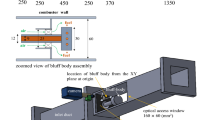Abstract
This study presents the methodological aspects of combustion instability modeling and pro-vides the numerical results of the model (sub-scale) combustion chamber, regarding geometrical dimensions and operating conditions, which are for determining the combustion stability boundaries using the model chamber. An approach to determine the stability limits and acoustic characteristics of injectors is described intensively. Procedures for extrapolation of the model operating parameters to the actual conditions are presented, which allow the hot-fire test data to be presented by parameters of the combustion chamber pressure and mixture (oxidizer/fuel) ratio, which are customary for designers. Tests with the model chamber, based on the suggested scaling method, are far more cost-effective than with the actual (full-scale) chamber and useful for injector screening at the initial stage of the combustor development in a viewpoint of combustion instabilities.
Similar content being viewed by others
Abbreviations
- Ath :
-
Nozzle throat area of rocket engine
- C:
-
Sound velocity
- C* :
-
Characteristic velocity
- f:
-
Frequency
- idem:
-
The same as the actual condition
- Km :
-
O/F mixture ratio\(( = \dot m_o /\dot m_f )\)
- L:
-
Length
- M:
-
Mach number
- \(\dot m\) :
-
Mass flow rate
- n i :
-
Total number of main injectors
- p:
-
Pressure
- Q:
-
Volumetric flow rate
- q:
-
Dynamic head ( = ρU2)
- R:
-
Stability margin
- U:
-
Injection velocity
- W:
-
Molecular weight
- α:
-
Excess-oxidizer coefficient
- αmn :
-
Eigenvalue variable
- П1 : Dependent stability parameter:
-
П2 : Governing (or independent) stability parameter
- ρ : Density:
-
τ : Characteristic time
- A:
-
Nominal or design operation regime of actual combustion chamber
- a:
-
Actial (full-scale) chamber or condition
- ch:
-
Combustion chamber
- chem:
-
Chemical reaction
- cyl:
-
Cylindrical part of combustion chamber
- (c):
-
With a closed end
- f:
-
Fuel
- fm :
-
Auxiliary injectors for film cooling
- i:
-
Per injector orifice
- ig:
-
Auxiliary injectors for ignition
- L:
-
Longitudinal mode
- liq:
-
Liquid
- m:
-
Model chamber or condition
- mix:
-
Mixing
- mL:
-
Them-th longitudinal mode
- noz:
-
Nozzle part of combustion chamber
- O2 :
-
Oxygen
- o:
-
Oxidizer
- (o):
-
With an open end
- tot:
-
Total
References
Culick, F. E. C. and Yang, V., 1995, in Liquid Rocket Engine Combustion Instability (V. Yang, and W. E. Anderson, eds.). Progress in Astronautics and Aeronautics, Vol. 169, AlAA, Washington DC, pp. 3–38.
Dexter, C. E., Fisher, M. F.. Hulka, J. R., Denisov, K. P.. Shibanov, A. A. and Agarkov, A. F., 1995, “Scaling Techniques in Liquid Rocket Engine Combustion Devices Testing.”The Second International Symposium on Liquid Rocket Engines, Paris.
Fisher, S. C, Dodd, F. E. and Jensen, R. J., 1995. inLiquid Rocket Engine Combustion Instability (V. Yang, and W. E.Anderson, eds.),Progress in Astronautics and Aeronautics, Vol. 169, AIAA, Washington DC, pp. 545–564.
Harrje, D.J. and Reardon, F. H. (eds.), 1972,Liquid Propellant Rocket Combustion Instability, NASA SP-194.
McManus, K. R., Poinsot, T. and Candel, S. M., 1993, “A Review of Active Control of Combustion Instabilities,”Progress in Energy and Combustion Science, Vol. 19, pp. 1–29.
Natanzon, M. S., 1986,Combustion Instability (Translated by F. E. C. Culick in 1996), Mashinostroyeniye, Moscow.
Seo, S., 2003, “Combustion Instability Mechanism of a Lean Premixed Gas Turbine Combustor,”KSME International Journal, Vol. 17, No. 6, pp.906–913.
Sohn, C. H., 2002, “Unsteady Analysis of Acoustic Pressure Response in N2 Diluted H2 and Air Diffusion Flames,”Combustion and Flame, Vol. 128, pp. 111–120.
Sohn, C. H., Seol, W. S., Lee, S. Y., Kim, Y. M. and Lee, D. S., 2003, “Application of Combustion Stabilization Devices to Liquid Rocket Engine,”Journal of The Korean Society for Aeronautical and Space Sciences, Vol.31, No. 6, pp. 79–87.
Sohn, C. H., Kim, S.-K. and Kim, Y. -M, 2004, “Effects of Various Baffle Designs on Acoustic Characteristics in Combustion Chamber of Liquid Rocket Engine,”KSME International Journal, Vol. 18, No. 1, pp. 154–161.
Sutton, G. P., 1992,Rocket Propulsion Elements, 6th Ed., John Wiley & Sons, Inc., New York.
Zucrow, M.J. and Hoffman, J. D, 1977,Gas Dynamics, Vol. II, John Wiley & Sons, Inc., New York.
Author information
Authors and Affiliations
Corresponding author
Rights and permissions
About this article
Cite this article
Sohn, C.H., Seol, WS., Shibanov, A.A. et al. On the method for hot-fire modeling of high-frequency combustion instability in liquid rocket engines. KSME International Journal 18, 1010–1018 (2004). https://doi.org/10.1007/BF02990873
Received:
Revised:
Published:
Issue Date:
DOI: https://doi.org/10.1007/BF02990873




